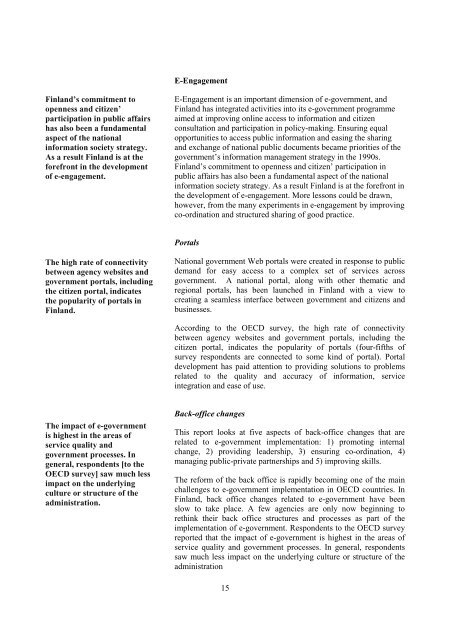e-GOVERNMENT IN FINLAND - ePractice.eu
e-GOVERNMENT IN FINLAND - ePractice.eu
e-GOVERNMENT IN FINLAND - ePractice.eu
Create successful ePaper yourself
Turn your PDF publications into a flip-book with our unique Google optimized e-Paper software.
Finland’s commitment to<br />
openness and citizen’<br />
participation in public affairs<br />
has also been a fundamental<br />
aspect of the national<br />
information society strategy.<br />
As a result Finland is at the<br />
forefront in the development<br />
of e-engagement.<br />
The high rate of connectivity<br />
between agency websites and<br />
government portals, including<br />
the citizen portal, indicates<br />
the popularity of portals in<br />
Finland.<br />
The impact of e-government<br />
is highest in the areas of<br />
service quality and<br />
government processes. In<br />
general, respondents [to the<br />
OECD survey] saw much less<br />
impact on the underlying<br />
culture or structure of the<br />
administration.<br />
E-Engagement<br />
E-Engagement is an important dimension of e-government, and<br />
Finland has integrated activities into its e-government programme<br />
aimed at improving online access to information and citizen<br />
consultation and participation in policy-making. Ensuring equal<br />
opportunities to access public information and easing the sharing<br />
and exchange of national public documents became priorities of the<br />
government’s information management strategy in the 1990s.<br />
Finland’s commitment to openness and citizen’ participation in<br />
public affairs has also been a fundamental aspect of the national<br />
information society strategy. As a result Finland is at the forefront in<br />
the development of e-engagement. More lessons could be drawn,<br />
however, from the many experiments in e-engagement by improving<br />
co-ordination and structured sharing of good practice.<br />
Portals<br />
National government Web portals were created in response to public<br />
demand for easy access to a complex set of services across<br />
government. A national portal, along with other thematic and<br />
regional portals, has been launched in Finland with a view to<br />
creating a seamless interface between government and citizens and<br />
businesses.<br />
According to the OECD survey, the high rate of connectivity<br />
between agency websites and government portals, including the<br />
citizen portal, indicates the popularity of portals (four-fifths of<br />
survey respondents are connected to some kind of portal). Portal<br />
development has paid attention to providing solutions to problems<br />
related to the quality and accuracy of information, service<br />
integration and ease of use.<br />
Back-office changes<br />
This report looks at five aspects of back-office changes that are<br />
related to e-government implementation: 1) promoting internal<br />
change, 2) providing leadership, 3) ensuring co-ordination, 4)<br />
managing public-private partnerships and 5) improving skills.<br />
The reform of the back office is rapidly becoming one of the main<br />
challenges to e-government implementation in OECD countries. In<br />
Finland, back office changes related to e-government have been<br />
slow to take place. A few agencies are only now beginning to<br />
rethink their back office structures and processes as part of the<br />
implementation of e-government. Respondents to the OECD survey<br />
reported that the impact of e-government is highest in the areas of<br />
service quality and government processes. In general, respondents<br />
saw much less impact on the underlying culture or structure of the<br />
administration<br />
15
















